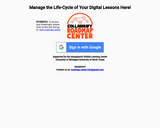
BrainVentures Wolves 3-5-Students learn about wolves as they read, write, listen, and create.
- Subject:
- Life Science
- Material Type:
- Assessment
- Homework/Assignment
- Author:
- UMCDC
- Date Added:
- 06/20/2021

BrainVentures Wolves 3-5-Students learn about wolves as they read, write, listen, and create.
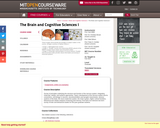
Survey of principles underlying the structure and function of the nervous system, integrating molecular, cellular, and systems approaches. Topics: development of the nervous system and its connections, cell biology or neurons, neurotransmitters and synaptic transmission, sensory systems of the brain, the neuroendocrine system, the motor system, higher cortical functions, behavioral and cellular analyses of learning and memory. First half of an intensive two-term survey of brain and behavioral studies for first-year graduate students. Open to graduate students in other departments, with permission of instructor.
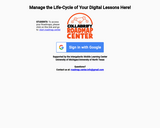
This Roadmap looks at the physical trait of a Hermit Crab that help it survive. The reading is leveled and guides the students to compare and recognize cause and effect within the reading. Students will then create a virtual aquarium and hermit crab of their own. Students will then learn how to use the animation feature of the Flipbook by making their hermit crab walk across the aquarium. Next they are open to make a book of their favorite animals in different environment. They will use a label to name the physical traits and tell how they help them survive.
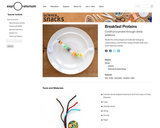
Construct a protein through cereal additions. Model the central dogma of molecular biology by constructing a colorful chain using a simple code (and some delicious cereal).
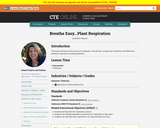
***LOGIN REQUIRED*** This lesson will discuss the process of respiration. We will also compare the similarities and differences between respiration and photosynthesis.
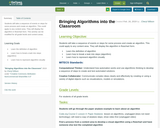
Students will take a sequence of events or steps for some process and create an algorithm. This could apply to any content area. They will display the algorithm in flowchart form. This activity can be modified for all grade levels and content areas.
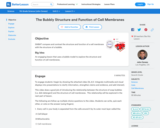
Objective
SWBAT compare and contrast the structure and function of a cell membrane with the structure of a bubble.
Big Idea
An engaging lesson that uses a bubble model to explore the structure and function of cell membranes.
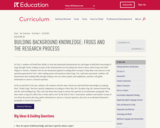
In Unit 2, students will build their ability to read and understand informational text and begin to build their knowledge of frogs through closely reading excerpts of the informational text Everything You Need to Know about Frogs and Other Slippery Creatures. Students will use the information gained in reading these excerpts to help them write answers to the questions generated in Unit 1 after reading poems and narratives about frogs. For a mid-unit assessment, students will demonstrate their reading skills through reading a new text about reptiles and amphibians, and they will gather information to answer a research question.
In the second half of the unit, students will continue with the same central text and build their knowledge by studying three "freaky frogs" that have specific adaptations according to where they live: the glass frog, the Amazon horned frog, and the water-holding frog. They will read about these frogs to answer this question in an informative paragraph: How does where a frog lives affect how it looks and/or acts? In the End of Unit 2 Assessment, students read another excerpt of text about the poison dart frog, gather information to answer a research question, and write an on-demand informative paragraph to answer the question.
RI.3.1, RI.3.3, RI.3.4, RI.3.5, RI.3.7, RI.3.8, W.3.2, W.3.7, W.3.8, L.3.1d,e, L.3.4
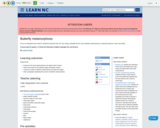
This is an integrated lesson which is introduced using the book "The Very Hungry Caterpillar" by Eric Carle. Butterfly metamorphosis is explored through art, math, and writing.
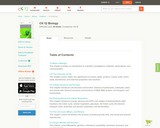
Submitted as part of the California Learning Resource Network (CLRN) Phase 3 Digital Textbook Initiative (CA DTI3), CK-12 Foundation’s high school Biology FlexBook covers cell biology, genetics, evolution, ecology, botany, zoology, and physiology. This digital textbook was reviewed for its alignment with California content standards.
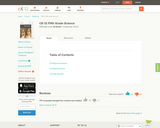
Fifth Grade Science curriculum used and maintained by the Utah Board of Education
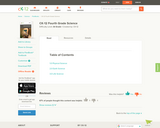
Physical, Earth, and Life Science for fourth grade. Used and maintained by the Utah State Board of Education
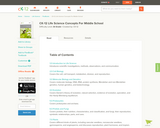
CK-12’s Life Science delivers a full course of study in the life sciences for the middle school student, relating an understanding of the history, disciplines, tools, and modern techniques of science to the exploration of cell biology, molecular biology, genetics, evolution, prokaryotes, protists,fungi, plants, animals, invertebrates, vertebrates, human biology, and ecology. This digital textbook was reviewed for its alignment with California content standards.
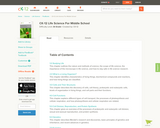
CK-12’s Life Science delivers a full course of study in the life sciences for the middle school student, relating an understanding of the history, disciplines, tools, and modern techniques of science to the exploration of cell biology, genetics, evolution, prokaryotes, protists, fungi, plants, the animal kingdom, the human body, and ecology. This digital textbook was reviewed for its alignment with California content standards.

A simulation that shows the rate and scope of spread of COVID-19 in a community. Students can change variables such as number of people, number of vaccinated people, workplace policies, school policies, etc.
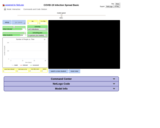
A simulation that shows the rate and scope of spread of COVID-19 in a community. Students can change variables such as number of people, schooling plans, etc. A more advanced version of this simulation can be found at https://openscied-static.s3.amazonaws.com/HTML+Files/COVID-19+Vaccination.html
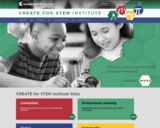
CREATE for STEM is a Michigan State University-sponsored research institute with a broad mandate for Collaborative Research in Education, Assessment and Teaching Environments for the fields of Science, Technology, Engineering, and Mathematics.
CREATE has five major focus areas for its work: Creating and Investigating Change in K-16 STEM Education, Educational Policy in STEM fields, Discipline-Based Undergraduate STEM Education, Developing Innovative and Digital Materials, and International Engagement with the Global STEM Education Community.
Within each of these areas, we build interdisciplinary and intergenerational research groups, foster new talent, provide seed money for initial work and support the grant writing process. CREATE is also a hub for the exchange of information and ideas, sponsoring conferences, workshops, seminars, and visiting scholars to enhance the interest in STEM Education and develop capacity in these fields here at MSU.

Vera Cubero created this framework to establish a common understanding between students and teachers regarding AI use in assignments. It addresses both the disclosure requirements and extent of AI usage.
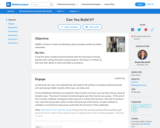
Objective
SWBAT construct a tower by following a clear procedure written by fellow classmates.
Big Idea
In the first lesson students became familiar with the importance of being specific when writing directions and procedures. This lesson is a follow-up that tests their ability to write and follow a procedure.
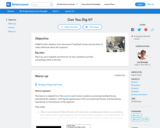
Objective
SWBAT build a skeleton from discovered "fossilized" bones and use them to make inferences about the organism.
Big Idea
Dig it up, put it together and discover its story. Students put their archaeology skills to the test.